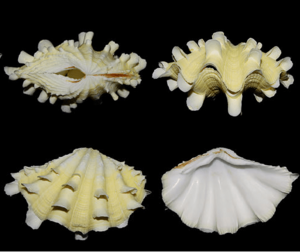Tridacna squamosa facts for kids
Quick facts for kids Tridacna squamosa |
|
|---|---|
 |
|
| Conservation status | |
| Scientific classification | |
| Synonyms | |
|
The fluted giant clam, also known as the scaly clam, is a large type of clam found in the ocean. Its scientific name is Tridacna squamosa. It belongs to a group of animals called bivalves, which means it has two shells that are hinged together.
This amazing clam lives in the warm, shallow coral reefs of the South Pacific and Indian Oceans. You can easily spot it because of the large, wavy, leaf-like edges on its shell. These edges are called 'scutes'. The clam also has a small opening called a 'byssal opening' which it uses to attach itself to rocks. The soft, fleshy part of the clam, called the mantle, can be many colors like brown, purple, green, or yellow, often with cool patterns. A fluted giant clam can grow to be about 40 centimeters (16 inches) wide!
When it's an adult, the clam stays in one place. Its mantle tissues are home to tiny, single-celled algae called zooxanthellae. These algae are like tiny plants that live inside the clam. They help the clam get most of its food. During the day, the clam spreads out its mantle so the algae can get lots of sunlight. This sunlight helps the algae make food through a process called photosynthesis.
Contents
Where Do Fluted Giant Clams Live?
The fluted giant clam lives in a wide area. You can find it from South Africa all the way to the Red Sea and even out to the Marshall Islands in the Pacific Ocean.
Keeping Fluted Giant Clams in Aquariums
Sometimes, people keep Tridacna squamosa in home aquaria. They need a bit of special care, but they are known to be quite strong compared to other giant clams.
Light and Food Needs
These clams need a good amount of light in their aquarium. This is because they rely on the zooxanthellae algae living in their mantle for some of their food. The algae need light to make food. However, the fluted giant clam is not as dependent on this light as some other giant clams. It also eats tiny floating organisms called phytoplankton to get all the nutrients it needs.
Living with Other Sea Creatures
Tridacna squamosa is a peaceful clam. It doesn't harm other animals in the wild or in an aquarium. But some animals, like anemones, triggerfish, and puffers, might try to eat the clam. It's best not to keep them with anemones, as an anemone might move too close and sting or eat the clam. Before adding a clam to an aquarium, it's a good idea to check it for tiny snails called Pyramidellidae snails. If possible, keep the clam by itself for a while to make sure it's healthy.
Placement in the Aquarium
In an aquarium, it's usually best to place the fluted giant clam lower down. Some clams like to sit directly on the sand or gravel at the bottom. Others might attach themselves to rocks that are a bit higher up using special threads called byssal threads.
Water Quality
All clams need very clean water to stay healthy. They can even help keep the water clean by using up some of the extra nitrates in the system. Nitrates are chemicals that can build up in aquarium water.
How We Protect Fluted Giant Clams
The IUCN (International Union for Conservation of Nature) lists the fluted giant clam as "lower risk" but says it still needs help from conservation efforts. This means that while it's not in immediate danger, we need to keep an eye on it and protect its habitats. The clam is also listed in Appendix II of CITES. This means that buying and selling these clams, or any parts of them, across countries is carefully controlled to make sure they are not over-harvested.
Images for kids








